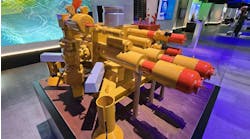View Article as Single page
FIV analysis
STAR-CCM+ was first executed in a stand-alone mode, assuming a rigid, fixed structure. These results were used to gain a better understanding of the internal forces due to the mixture in the system and served as the initial solution for the two-way coupled co-simulation.
For co-simulation, on the VOF side, the second order implicit segregated solver using the k-omega SST turbulence model was run unsteady, with a time step providing a Convective Courant Number value of ~0.5 on most of the phase separation surface. This corresponds to 1/100th of the period of the fourth natural mode and 1/63th of the period of the seventh natural mode of the structure and ~1/150th of time for the mixture to travel along pipe bend. Gravity was included in the simulation and the inlet velocity was set to 3 m/s (9.8 ft/s).
The undeformed structure was used as the initial condition for the Abaqus runs. In addition to the added mass, the structural model also included a mass proportional damping to account for damping from the external water surrounding the pipes and some additional damping in joints on jumper ends5. The value of the damping coefficient representing the mass proportional damping was obtained by running a fully two-way coupled simulation on a flexible round pipe in water. For all simulations, attention focused on the first sven natural modes of the structure, with their natural frequencies ranging from 0.59 to 2.82 Hz.
Jumper bends are the primary spots for significant loading as a result of the large momentum from the change in direction of flow. The multi-phase flow encountered by the bends is highly complex with a lot of identifiable peaks in frequency. This means that there are many transient pressure loadings that have the potential to give rise to changing stresses and oscillatory vibrations, thus affecting fatigue and lifetime of the jumper. The primary dominant frequencies observed in the FFT of the forces on the bends were low with time scales of up to 10 seconds. These are due to the separation of the phases in the mixture (development of slugs) as it flows through the jumper. Although these frequencies are much lower than the natural modes of the structure, they are a critical component for predicting the fatigue life of the jumper.
As the mixture moves through the jumper and arrives at the fourth bend, longer slugs are forming, and as they pass the second lift they have reached a length of ~12 pipe diameters long.
The dominant slug frequencies indicate that the slugs have relatively large time scales with the first dominant frequency around 0.09 Hz. Because of this, each slug moving along the pipe produces kind of impulse loading, resulting in structural vibrations mainly with structural natural frequencies. This can be seen from FFT of jumper displacements at controlled points. In addition, one of the slug frequencies is observed to be close to the first fundamental mode of the system at 0.54 Hz.
Prediction of fatigue failure
Von Mises stresses and displacements for the system were computed and the largest tensile stresses were observed in the cantilevered section of the pipe that is clamped in the simulation and hooks into neighboring equipment in real-life scenarios. This was identified as a prime candidate location for prediction of fatigue failure of the jumper because a weld usually is located at this place and it is subjected to tension. The time dependent behavior of the stress at this location and its FFT show a distinct peak with a dominant frequency at 1.3 Hz and falls close to the frequency of second natural mode. In addition, a low frequency response of 0.09 Hz is again present due to the transient motion of slugs in the jumper. Using the results of the stresses at this critical location as an input, the Rain Flow Counting Technique estimated the damage to the jumper from the presented portion of altering stress. The result shows a range in stress relative to the mean stress and number of cycles. The Palmgren-Miner rule, using the S-N curve2 predicted a short fatigue life of about 5.5 years with a fatigue design factor of five.
This example demonstrates the value of using high-fidelity simulation to assess fatigue life early in the design process. A potential structural vibration problem is identified up front and additional simulations can be performed at a low cost to redesign the jumper and mitigate the problem.
Conclusion
Flow induced vibration and its effect on fatigue life of a generic jumper was assessed using a two-way coupled FSI simulation with STAR-CCM+ and Abaqus FEA. Simulations with the multi-phase VOF model in STAR-CCM+ were robust with minimal numerical problems. The dominant frequencies from the slug formation for the jumper geometry used were lower than the natural frequencies of the structure. This suggests that a coupling between the fluid and structure could be treated via a one-way coupling. However for a one-way coupling, the added fluid mass and added fluid damping due to the internal VOF flow would be difficult to predict. For that reason, fully two-way coupled simulations provide insight to the expected damping which in turn greatly influences the lifetime estimates. This method should add significant value as it can be applied to complex real-world problems involving non-linear structures and complicated subsea equipment.
More expensive simulation tools will benefit failure analysis prediction and prevention in subsea systems. Anticipation of structural integrity early in the design should help quantify and reduce the conservatism currently used, keeping production flow rates as high as possible to ensure the profit margin.




